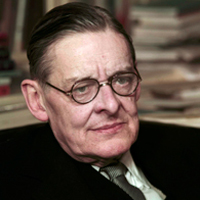Rhapsody on a Windy Night by T. S. Eliot: Summary and Critical Analysis
The poem Rhapsody on a Windy Night presents the setting of a moonlight windy night, and the time is twelve o'clock. The street is deserted. The young man, the speaker, walks down a street in which the street lamps eventually dominate his walk so much so as to act as triggers to series of fanciful and disorganized imaginings. The young man is returning to his lodge.

T. S. Eliot (1888-1965)
He walks along the reaches of the streets, where the moonlight has reduced all things to uniformity (silver color) and which seem to be whispering into his ears their stories of the night, their sordid experiences of men and their actions to which the streets have borne silent witnesses.
He is virtually moonstruck; his memory is disorganized as that of a lunatic. The rational pattern of memory is here completely dissolved, giving place to a 'lunar synthesis' which has a logic of its own- the logic of distortion. As he passes by a lamp post, it seems to be telling out his or somebody's fate. It stimulates him to the remembrance of unlikely, confused, and mainly ugly things. The memories are pointless and are dead and useless as the flower is that the madam shakes, though they once had a vigorous and brilliant life as the geranium had.
In the poem "Rhapsody on a Windy Night," the "I" of the poem experiences, as he walks, a mental struggle between two views of the world, one active, focused on the moving present, and one passive, focused on the inert past. This struggle is expressed through two images, that of the street lamp and that of memory. The poem alternates between their two perspectives, so that stanza 2nd deals with the lamp, stanza 3rd with memory; lines 33-37 with the lamp, lines 38-39 with memory; lines 46-61 with the lamp, lines 62-68 with memory; and stanza 6 with the lamp.
"Rhapsody on a Windy Night" describes a town scene and is based on a musical idea. Details in this poem- including the sight of the street- lamps, the woman in the doorway, the smells, the memories- are derived from the novel Babu de Montparnasse (1898) by Charles- Louis Philippe. Eliot composed this poem in the characteristic manner of the French symbolists, especially Laforgue, who concentrated a number of fragmented, broken images to suggest the sordid life and squalor of a modern city. Its purpose is to evoke a mood of nightmarish horror as well as to convey an idea of the squalor of urban life. The windy moonlight night distorts the unhappy memories of the speaker into a nightmare as he walks along the gas lit streets. The theme is the passage of time, and the street- lamp at various times of the night releases the memory from its routine organization. This poem is another version of the dirt and filth of the urban rubbish observed by the speaker while walking down a street in the midnight and reaching his residence at four a.m.
The poem subverts the romantic connotations of the title. The term 'rhapsody' was originally used for a portion of an epic poem, such as a book of the Iliad, adapted for recitation. It is used in a general sense for any ecstatic, highly emotional utterance; and it can also refer to a fragmented, disconnected series. In music, 'rhapsody' is an instrumental composition, improvisational, and irregular and form, the most famous being Franz Liszt's 'Hungarian Rhapsodies' for the piano.
Rhapsody on a Windy Night" does not have a regular stanzaic pattern. It is composed of strophes, which are irregular rhetorical units of free verse, determined by rhythmic or emotional completeness rather than by metrical pattern. The structure of the poem is carefully controlled, however, although it might appear to be a collage of fragmented images.
There is a complex tracery of closely interconnected images in the poem. For instance, the eye of the prostitute which twists like a crooked pin evokes memories of 'a twisted branch upon the beach' and 'a crowd of twisted things', which lead on to the 'last twist of the knife' at the end of the poem. The image of the eye is also interlinked with the vacancy of the child's eye, the eyes in the street trying to peep through lighted shutters, and the feeble eye of the moon. There is an absence of discursive and connecting comments. The moon, without a transition, becomes a prostitute. The identity of metaphor here evokes the similarity between the two-the amnesiac moon without a consciousness, and the woman, like an automation, who mindlessly twists a paper rose.
Cite this Page!
Shrestha, Roma. "Rhapsody on a Windy Night by T. S. Eliot: Summary and Critical Analysis." BachelorandMaster, 25 Nov. 2013, bachelorandmaster.com/britishandamericanpoetry/rhapsody-on-a-windy-night.html.
Related Topics
The Waste Land: Critical Analysis
Journey of the Magi: Summary and Analysis
Morning at the Window: Summary and Analysis
The Love Song of J. Alfred Prufrock: Summary
Sweeney among the Nightingales: Analysis
The Hollow Men: Critical Analysis
Portrait of a Lady: Summary and Analysis
Thomas Sterne Eliot: Biography
 |
bachelorandmaster.com |